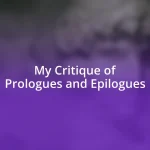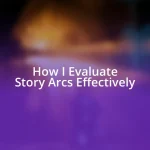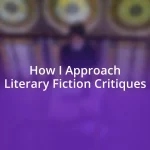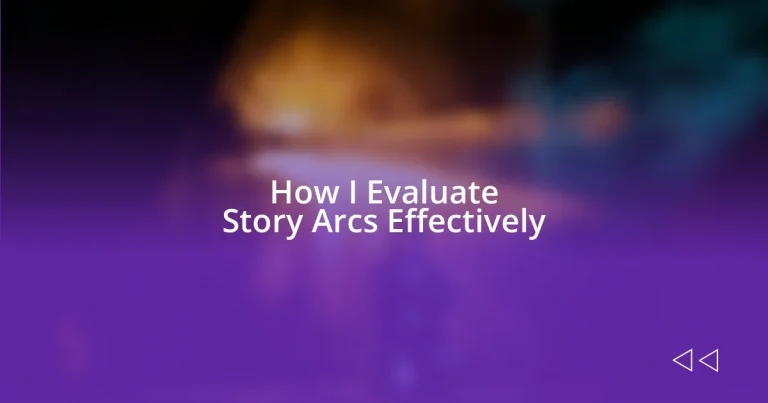Key takeaways:
- Understanding key elements of story arcs—exposition, rising action, climax, falling action, and resolution—enhances audience engagement and emotional impact.
- Effective evaluation techniques, including visual plot diagrams, character journey analysis, and audience feedback, improve the crafting and resonance of story arcs.
- Refining arcs involves deepening character development, increasing stakes, and focusing on emotional connections to create a lasting impression on readers.
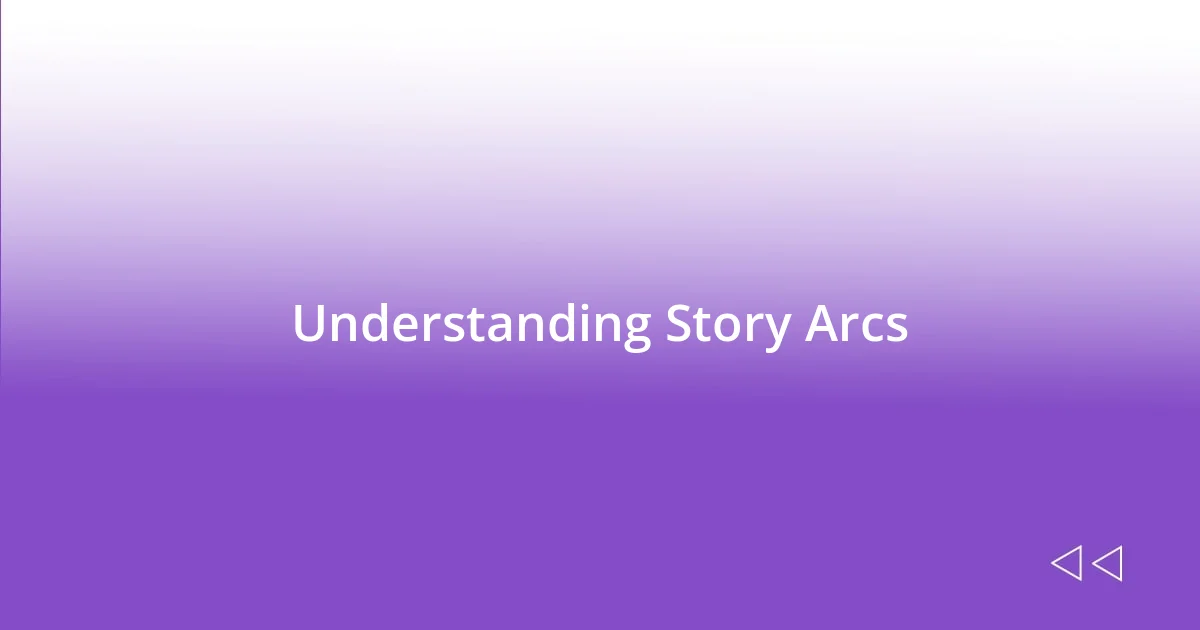
Understanding Story Arcs
When I first started diving into storytelling, I found the concept of a story arc to be both fascinating and essential. A story arc, in essence, is the structure that guides a narrative from the introduction of characters and conflict to the resolution. It’s like a roadmap: without it, the journey can become chaotic and confusing.
Think about the last gripping novel or movie you enjoyed. Did you notice how the main character faced challenges, experienced growth, and ultimately reached a satisfying conclusion? For me, recognizing these phases within the story helped me appreciate the craft behind storytelling. It made me wonder: how do different arcs shape our emotional responses as viewers or readers, and why do some resonate more than others?
As I explored various genres, I discovered that the most memorable arcs often evoke powerful emotions. For instance, when I read a coming-of-age story, the protagonist’s journey from innocence to experience mirrored my own youthful struggles. It’s these personal connections that make story arcs truly impactful, bridging the gap between fiction and our lived experiences. How have story arcs influenced your feelings in stories you cherish?
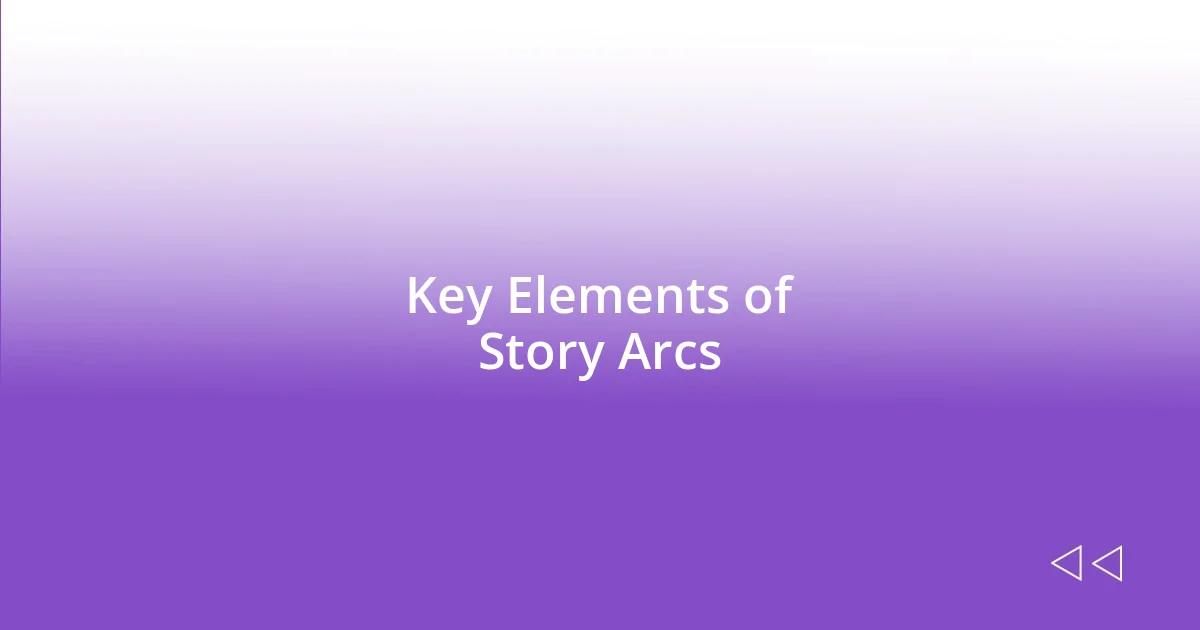
Key Elements of Story Arcs
Key elements of story arcs are the driving forces that shape how we connect with a narrative. From my experience, understanding these elements not only enhances the storytelling process but also enriches the audience’s engagement. At the heart of a solid story arc are the following components:
- Exposition: This introduces the characters, setting, and initial situation. I recall how the opening of a fantasy novel always hooked me by painting a vivid world.
- Rising Action: Conflicts and complications arise, leading to increased tension. I still remember the thrill I felt when the stakes were raised in my favorite film—every twist kept me on the edge of my seat.
- Climax: The turning point where the main conflict reaches its peak. This is often the moment when I find myself holding my breath in anticipation, completely absorbed in the outcome.
- Falling Action: Here, the tension starts to decrease as the story moves towards its resolution. I appreciate stories that take their time here, allowing characters to reflect on their experiences.
- Resolution: The conclusion ties up loose ends and resolves the story’s conflicts. It’s those satisfying endings that linger in my mind, often leading to my own reflections long after the story concludes.
Each of these elements plays a critical role in how a narrative unfolds, and I’ve found that when they’re executed skillfully, they create a more immersive and emotional experience for the audience. Remembering how different arcs affect me personally helps me appreciate the subtleties of storytelling even more.

Techniques for Evaluating Arcs
Evaluating story arcs effectively involves a mix of assessing structural elements, understanding character development, and gauging emotional impact. One technique I find valuable is creating a visual plot diagram. This visual representation helps pinpoint where the story peaks and how well the rising action builds tension. When I drew out the arc for a recent short story I wrote, I realized that the climax didn’t just happen; it was orchestrated through the protagonist’s inner growth, making that turning point feel authentic.
Another technique is to analyze character journeys. I often ask myself: does the main character evolve in a believable way? By comparing their starting point with where they end up, I can gauge whether the arc feels satisfying. For example, when I watched a recent film, the protagonist’s evolution from doubt to confidence resonated deeply with me. It was a reminder of my own experiences, and recognizing that connection enhanced my appreciation for the narrative.
Lastly, engaging with your audience’s feedback can be incredibly insightful. I often share my drafts with friends and ask them which parts moved them the most. Their insights have guided my revisions and deepened my understanding of how different arcs resonate on an emotional level. I remember one piece that left my readers in tears, and it became clear that the shared struggles of the characters had struck a chord. This feedback loop is invaluable for honing the effectiveness of story arcs.
| Technique | Description |
|---|---|
| Visual Plot Diagram | A graphical representation of the story arc to identify peaks and structure. |
| Character Journey Analysis | Assessing character evolution to ensure believable arcs. |
| Audience Feedback | Gathering insights from readers to understand emotional impact. |
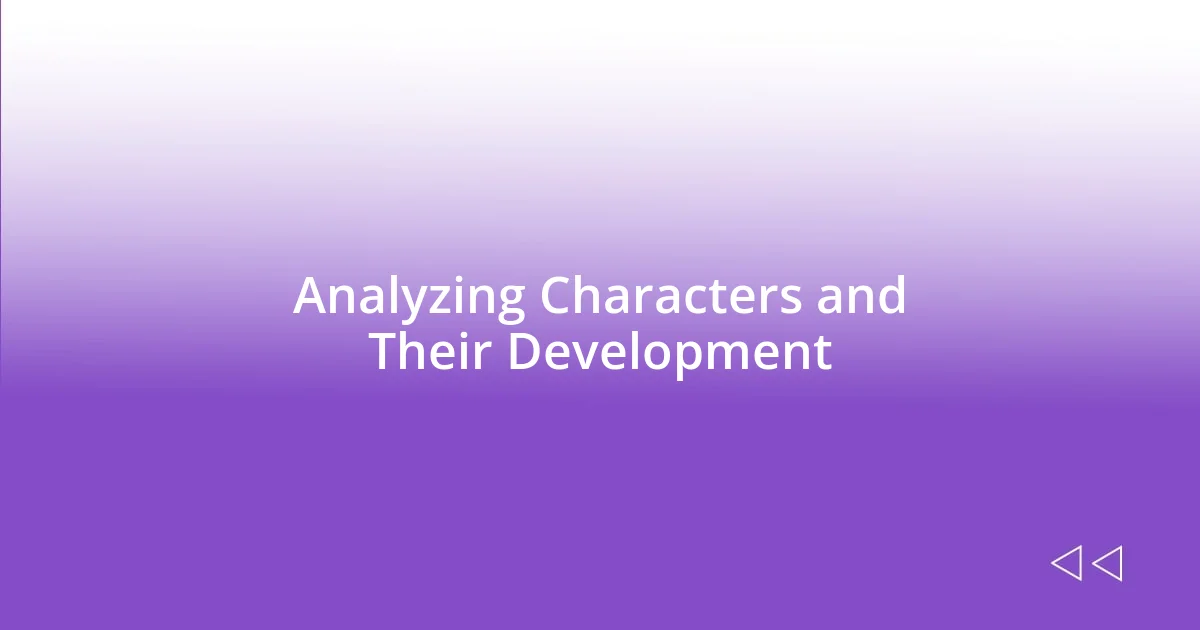
Analyzing Characters and Their Development
When analyzing characters, I often look closely at their motivations and how they change throughout the story. For instance, I remember a character in a novel I read who began as a selfish individual but slowly learned the value of community and sacrifice. Witnessing that transformation was powerful; it made me reflect on my own life experiences where I too had to confront my shortcomings to grow.
Another aspect I consider is the complexity of characters. Are they multidimensional, or do they fall flat? I once critiqued a screenplay where the antagonist was portrayed with depth and vulnerability, which made me rethink my initial bias against ‘villains.’ This layered approach to character development not only humanized them but added an emotional weight to the story that lingered with me long after watching.
Moreover, I find it intriguing how relationships between characters can highlight development. In one of my favorite TV series, a character’s arc was closely tied to her friendship with another character. Each challenge they faced together revealed something new about them, profoundly illustrating their growth. It raised the question for me: how often do we overlook the power of relationships in shaping who we become? The answer is that these connections often provide the richest avenues for development, making the narrative all the more compelling.
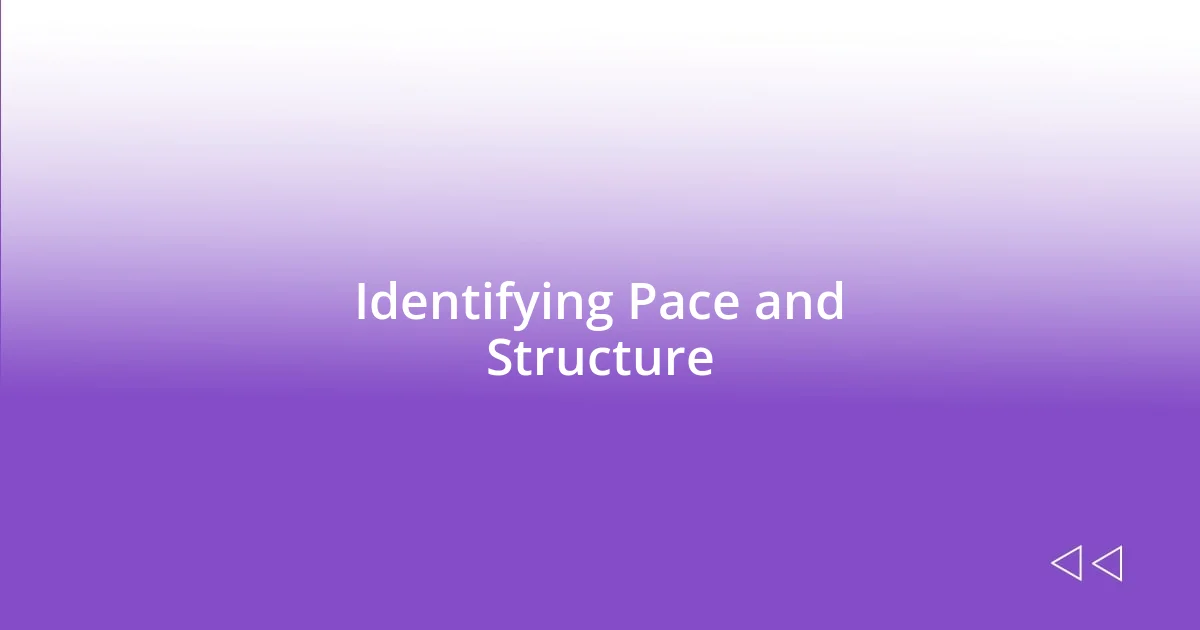
Identifying Pace and Structure
Identifying the pace and structure of a story is like tuning into the rhythm of a song. In my experience, I often find that a well-paced narrative has its own heartbeat; you can sense when it quickens during high-stakes moments and slows to immerse us in quieter scenes. Recently, I read a mystery novel that expertly balanced action and introspection. Just when I thought I had everything figured out, the author slowed things down to delve into the detective’s past, enriching my understanding and appreciation of the character.
When evaluating structure, I typically ask myself if the story adheres to a recognizable format, such as the classic three-act structure or a nonlinear approach. For example, I once crafted a story that turned the traditional structure on its head by weaving timelines together. That challenge taught me how a non-linear format can create suspense and intrigue, drawing readers deeper into the narrative. It often leads me to wonder: does bending the rules sharpen a story’s impact, or does it risk losing the audience?
I also pay close attention to transitions between scenes and chapters. A smooth transition can make or break the flow, guiding the reader seamlessly through the plot. I’ll never forget the frustration I felt while reading a book that abruptly jumped from one scene to another without any context. It jarred me out of the experience. Conversely, when transitions are handled well—like in a novel where echoes from one chapter resonate in the next—everything feels interconnected, creating a richer narrative tapestry. How do we master the delicate art of pacing and structure? It’s all about finding that balance between movement and stillness, engagement and reflection.
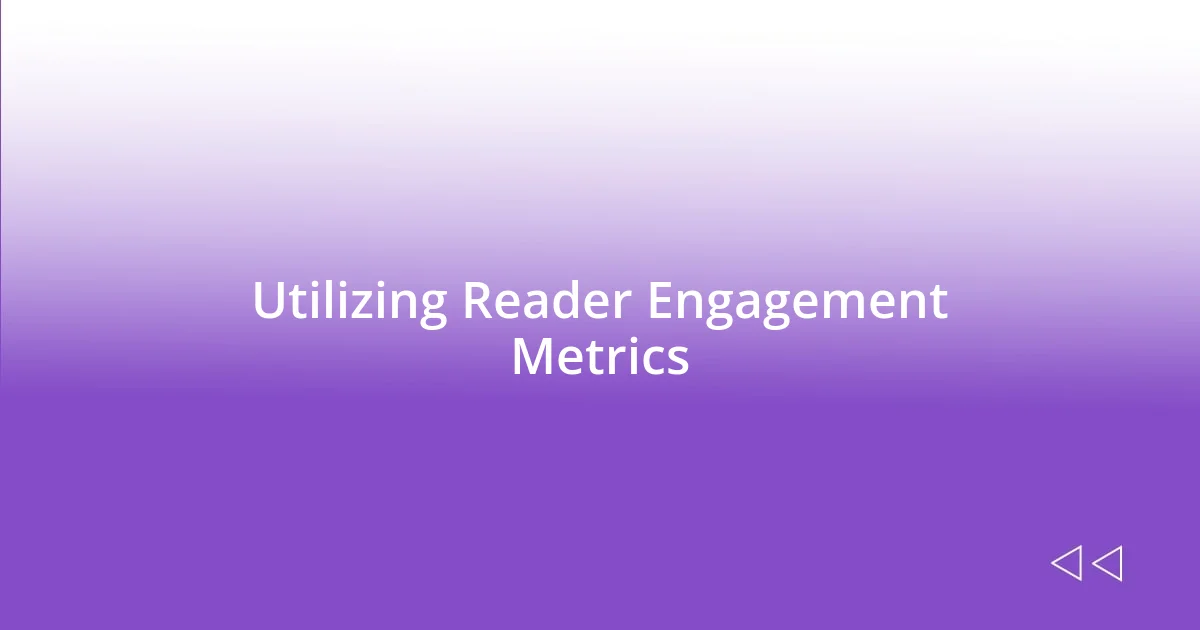
Utilizing Reader Engagement Metrics
Reader engagement metrics are essential tools that can inform how effectively a story arc resonates with its audience. I once analyzed the engagement statistics of a serialized novel and realized that chapters with cliffhangers drew significantly more interactions compared to those that wrapped up neatly. This piqued my interest—what is it about suspense that holds us captive? It’s that palpable tension that keeps readers craving more, allowing them to feel connected to the narrative.
I often find value in looking at analytics like scroll depth and time spent on particular sections. For example, in a blog post I wrote, I noticed that readers tended to linger longer on a section with a revealing plot twist. This real-time feedback helps me understand what elements engage my audience most effectively. It also raises questions about how we, as writers, can harness those moments of surprise to maintain momentum in our storytelling.
Yet, it’s crucial to pair these metrics with qualitative feedback. I remember hosting a small reading group where we discussed a short story that received mixed reviews online. What surprised me was how personal interpretations varied greatly, even when the metrics indicated that it was generally well-liked. This experience taught me that while numbers provide insight, the emotional reactions of readers offer depth that can sometimes be overlooked. How can we balance hard data with these rich, subjective experiences? It’s a dance of sorts, revealing the intricate relationship between story and audience.
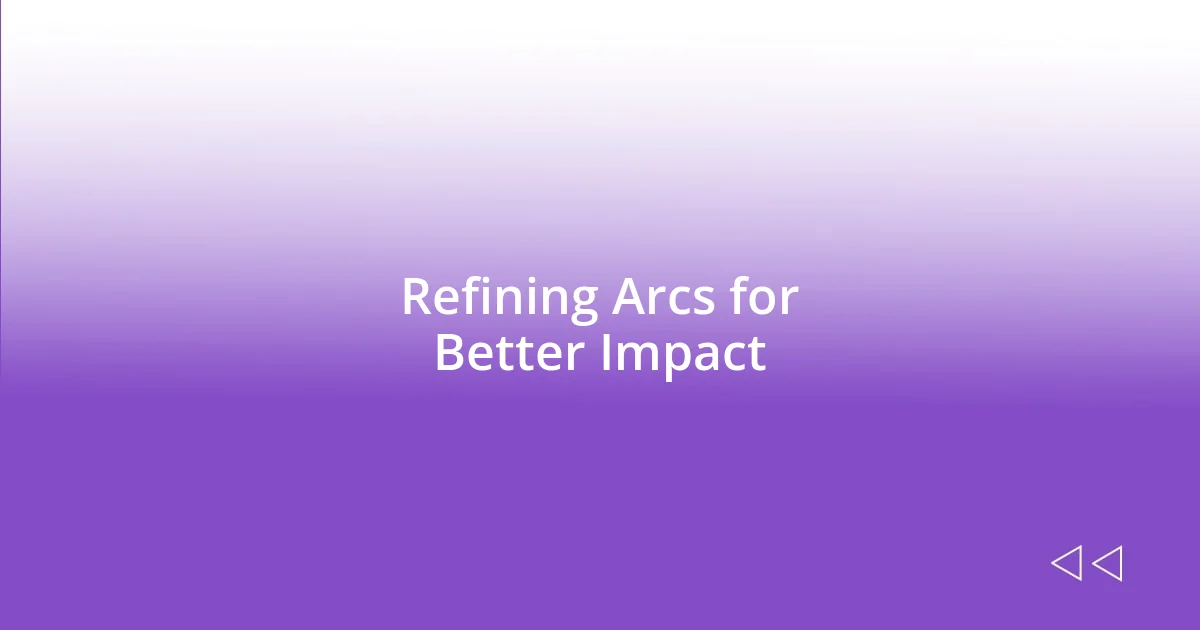
Refining Arcs for Better Impact
Refining story arcs isn’t just about tweaking plot points; it’s an exploration of emotional resonance. I remember working on a personal essay where I initially struggled with the ending. After several drafts, I decided to pull back and refine the emotional high point. By focusing on the protagonist’s internal conflict rather than a sudden resolution, I made readers reflect on their own experiences. It’s incredible how a subtle shift can lead to a deeper connection and leave a lasting impact on the audience.
Another aspect that greatly affects the arc is character development. While developing a YA novel, I learned that multidimensional characters with flaws and growth create a more engaging journey. At one point, I decided to rewind and delve into my protagonist’s fears instead of just their triumphs. This shift not only refined the arc but also helped resonate with readers on a more personal level. Have you ever paused to reconsider what drives your characters? It’s these layers that can refine a story’s emotional core, making it more relatable and impactful.
Moreover, I find that assessing the stakes throughout the story is crucial to refining arcs. In one instance, I revised a short story where the stakes initially felt low, making it easy for readers to disengage. By elevating the consequences of the protagonist’s decisions, I transformed the arc into something that felt urgent and compelling. This experience has fueled my belief that amplifying the stakes not only enhances the excitement but also invites readers to invest emotionally. What are the stakes in your stories? Ensuring they are clearly defined can elevate your narrative into something extraordinary.
